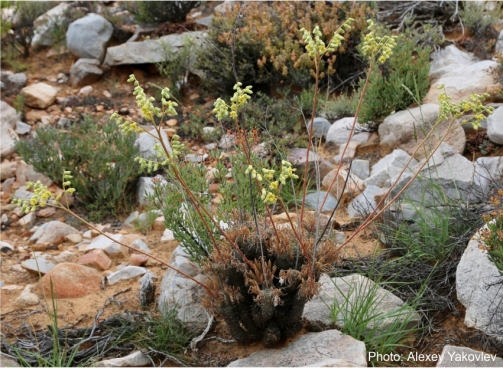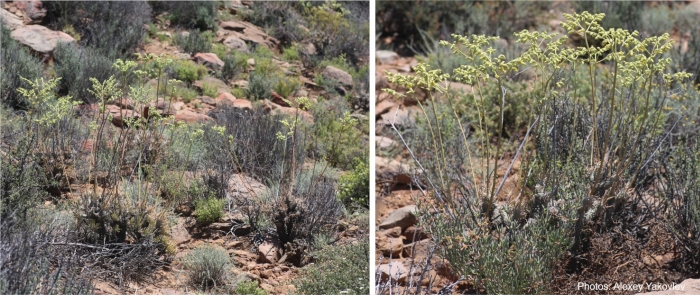Tylecodon wallichii subsp. wallichii
Tylecodon wallichii (Harv.) Toelken. subsp. wallichii
Family: Crassulaceae
Common names: pegleg butterbush, quiver bush (Eng.); kokerbos, kandelaarbos, krimpsiektebos, krimpsiekkandelaar, nenta, bandjiesbos, tnjoemsganna, koni-ganna, karkeibos, poppebos (Afr.)
Introduction
A succulent shrub with thick, knobby branches and many nodding, pale greenish-yellow flowers on long stems in early summer. It is widely spread in dry, winter-rainfall parts of the Western, Northern and Eastern Cape of South Africa. Its unusual spiky stems and attractive, upright habit make it a striking ornamental plant, best suited to dry gardens or containers.

Description
Description
Tylecodon wallichii subsp. wallichii is a deciduous, succulent shrub about 600 mm tall, with sparse and thick branches. The stem is grey-green to grey-brown and is covered with knobby outgrowths; these are phyllopodia, which are old, hardened, elongated leaf scars left on the stem after the leaf drops off. The size of the phyllopodia varies greatly. The leaves are yellowish to grey-green, up to 150 mm long, cylindrical, thin and narrow, erect and crowded at the tip of the branch.

These plants flower in early summer, producing a cluster of nodding yellowish-green flowers on short stalks at the tip of a long peduncle, 300 to 600 mm in length. The flowers are about 10 mm long, cylindrical to urn shaped with recurved or recoiled lobes.

Tylecodon wallichii has a twin species named T. cacaliodes and they are almost impossible to differentiate in the vegetative stage, but they can be told apart by their flowers: those of T. wallichii are considerably shorter and on the inside of their corolla tubes there are glandular hairs.
Conservation Status
Status
According to the Red List of South African Plants, Tylecodon wallichii subsp. wallichii is not threatened or endangered and is therefore listed as Least Concern (LC). Because the plants are toxic to grazing animals, they are often removed by farmers and although the full extent of the ecological consequences of this practice are unkown, it could cause the species to become threatened in future.

Distribution and habitat
Distribution description
Tylecodon wallichii subsp. wallichii is a South African endemic plant, found in the Eastern Cape, Western Cape and Northern Cape. This plant grows naturally in the sandy and gravelly soils of Namaqualand, the Great and Little Karoo, from near Kamieskroon to near Oudtshoorn, on mountain tops, rocky ridges, stony flats and on lower lying slopes. This plant flourishes in a winter-rainfall climate, where they experience hot dry summers and cold frosty winters. These plants are drought-tolerant and can survive a period of time without water.

Derivation of name and historical aspects
History
In the past, all the plants in this genus were placed under the genus Cotyledon, but this was changed in 1978 by taxonomist Helmut Toelken. He moved all the deciduous plants and plants with a spiral leaf arrangement to a new genus, Tylecodon. The name Tylecodon is an anagram (word formed by rearranging letters of another word) of Cotyledon. Tylecodon currently has 46 species, making it the second largest genus in the Crassulaceae family. Most species are endemic to southern Africa and occur in the dry regions of South Africa and Namibia.
The specific epithet wallichii is in tribute to Nathaniel Wallich (1785-1854), who was a Danish surgeon and botanist. Nathaniel Wallich played a big role in the development of the Calcutta Botanical Garden. He collected numerous botanical specimens in Asia and South Africa, which led to the development of a large herbarium collection that was distributed to herbaria in Europe.

Ecology
Ecology
Tylecodon flowers attract and are pollinated by the long-proboscis horsefly (Masarina tylecodoni), sunbirds (long-billed nectar-feeding birds), and long-tongued pollen wasps.
Tylecodon wallichii subsp. wallichii is deciduous during the dry summer months, when it drops its leaves. New leaves appear in autumn, at the start of the rainy winter growing season. The leaves are dry when it flowers in early summer. Its fleshy stems allow it to thrive in arid regions and survive long periods of drought.
Tylecodon wallichii subsp. wallichii has formed hybrids with T. wallichii subsp. ecklonianus, T. paniculatus and T. cacalioides, which is a result of how closely they grow in their natural habitat.

Uses
Use
Plants in this genus, including T.wallichii are poisonous to livestock, causing a disease called Cotyledonosis or Krimpsiekte which affects the digestive system of the animal. The plants contain cotyledoside, a neurotoxin that attacks the nervous system, leading to paralysis and death. The leaves and stems of the plants are poisonous when eaten, and it is not recommended that people with livestock, pets or children grow this plant.
The leaves are warmed and used as a poultice, plaster or compress to treat blisters, wounds and boils, and pounded stem is used to treat whitlow finger.
Tyledodon wallichii can be grown as a pot plant, planted in a waterwise rockery garden and used in xeriscaping. Its upright habit and thick stems give it the appearance of a succulent bonsai.

Growing Tylecodon wallichii subsp. wallichii
Grow
Tylecodon wallichii is easy to grow and can be propagated through both seeds and cuttings. The best time to sow seeds and make cuttings is in autumn. This gives the plant a full winter to develop before dormancy. Seeds are ready to be sown when they are harvested. Sow these tiny seeds uncovered, in a layer of coarse sand, on top of potting soil suitable for succulent plants that must be well-drained (e.g. with added river sand). The seeds germinate easily, in just 8 weeks you can start to see the first leaf above ground although in will take 10-20 years for the plant to reach maturity. Cuttings must be planted in well-drained soil. Please water the plant consistently before the roots form.
Grow Tylecodon wallichii in full sun, in well-drained, sandy or sandy loam soil. Plants grow in winter and are dormant in summer. Water moderately in winter and reduce watering in spring. During dormancy (in summer), it needs little or no water. Overwatering or poor drainage will cause the plant to rot.
References
- Botha, C.J. & Van Wyk, A.E. 2022. What is in a name? Scientific name changes of potentially poisonous plants and fungi in South Africa. Journal of the South African Veterinary Association 93(2): 1-6. https://dx.doi.org/10.36303/JSAVA.160.
- Cheeke, P.R. 1989. Toxicants of plant origin, Volume II, Glycosides. CRC Press, USA.
- Court, D. 1981. Succulent flora of southern Africa. Balkema, Cape Town.
- Eggli, U. (ed.) 2003. Illustrated handbook of succulent plants: Crassulaceae. Springer, Berlin.
- Gess, R. 2001. Tylecodon cacaloides and a long-proboscid horse-fly. Veld & Flora 87(3):1271. Available at http://pza.sanbi.org/sites/default/files/info_library/tylecodon_cacalioides_pdf.pdf.
- Gess, S. et al. 1998. Birds, wasps and tylecodons: pollination strategies of two members of the genus Tylecodon in Namaqualand. Veld & Flora 84: 56-57. Available at http://pza.sanbi.org/sites/default/files/info_library/tylecodon.pdf.
- Glavich, T. 2017. Beginner’s guide to the smaller Tylecodon. Cactus and Succulent Journal 89(1): 34-37.
- Harvey, W.H. & Sonder, O.W. 1861-1862. Flora Capensis: Being a Systematic Description of the Plants of the Cape Colony, Caffraria and Port Natal, and Neighbouring Territories. Hodges, Smith and Co., Dublin.
- LLIFLE. Encyclopedia of succulents. Tylecodon wallichii (Harv.) Toelken. http://www.llifle.com/Encyclopedia/SUCCULENTS/Family/Crassulaceae/17349/Tylecodon_wallichii. Accessed 05/07/2022.
- Manning, J. 2009. Field guide to wild flowers of South Africa. Struik Nature, Cape Town.
- Nortje, J.M. 2011. Medical ethnobotany of the Kamiesberg, Namaqualand, Northern Cape Province, South Africa. Dissertation for Master of Science in Botany, University of Johannesburg, South Africa.
- Oliver, I. & Reynolds, Y. 2002. Tylecodon paniculatus (L.f.) Tölken. (Crassulaceae). PlantZAfrica. Online. http://pza.sanbi.org/tylecodon-paniculatus.
- Palm, D. 2021-12-19. Observation of Tylecodon wallichii, Breede Valley Municipality, WC. iNaturalist. Online. https://www.inaturalist.org/observations/103296335.
- Palm, D. 2021-12-22. Observation of Tylecodon wallichii, Breede Valley Municipality, WC. iNaturalist. Online. https://www.inaturalist.org/observations/103473778.
- Plug, C. 2021. Wallich, Dr Nathaniel (botany). S2A3 Biographical Database of Southern African Science. Online. https://www.s2a3.org.za/bio/Biograph_final.php?serial=3033.
- Raimondo, D., Von Staden, L., Foden, W., Victor, J.E., Helme, N.A., Turner, R.C., Kamundi, D.A. & Manyama, P.A. (eds) 2009. Red list of South African plants. Strelitzia 25. South African National Biodiversity Institute, Pretoria.
- Rebelo, T. 2012-04-27. Observation of Tylecodon wallichii ssp. wallichii. Tankwa Karoo National Park, Northern Cape. iNaturalist. Online. https://www.inaturalist.org/observations/10816833.
- Rebelo, T. 2012-08-10. Observation of Tylecodon wallichii ssp. wallichii. Tankwa Karoo National Park, Northern Cape. iNaturalist. Online. https://www.inaturalist.org/observations/10847440.
- Rebelo, T. 2015-09-24. Observation of Tylecodon wallichii ssp. wallichii. Hammelhoek-á Game Farm, Northern Cape. iNaturalist. Online. https://www.inaturalist.org/observations/11120788.
- San Marcos Growers online. Tylecodon wallichii - Pegleg butterbush. https://www.smgrowers.com/products/plants/plantdisplay.asp?plant_id=4642. Accessed 06/07/2022.
- Smith, G.F., Crouch, N.R. & Figueiredo, E. 2017. Field guide to succulents in southern Africa. Struik Nature, Cape Town.
- Tölken, H. 1977. New taxa and a new combination in the genus Cotyledon. Bothalia, 12(2):191-194.
- Tölken, H.R. 1985. Crassulaceae. Flora of Southern Africa 14: 1–229.
- Vleggaar, R. et al. 1997. Krimpsiekte, associated with thalamic lesions, induced by the neurotoxic cardiac glycoside, cotyledoside, isolated from Tylecodon wallichii subsp. wallichii. Onderstepoort Journal of Veterinary Research 64:189-194.
- World of Succulents. Tylecodon wallichii (Pegleg butterbush). https://worldofsucculents.com/tylecodon-wallichii-pegleg-butterbush/. Accessed 06/07/2022.
- World of Succulents, Succulentopedia. How to grow and care for Tylecodon. https://worldofsucculents.com/grow-care-tylecodon/. Accessed on 10 Jul. 2019.
- Yakovlev A. 2017-09-10. Observation of Tylecodon wallichii ssp. wallichii, Nieuwoudtville Waterfall, Northern Cape. iNaturalist. Online. https://www.inaturalist.org/observations/143993923.
- Yakovlev A. 2021-12-13. Observation of Tylecodon wallichii ssp. wallichii, Anysberg Nature Reserve, Western Cape. iNaturalist. Online. https://www.inaturalist.org/observations/106967014.
- Yakovlev A. 2021-12-14. Observation of Tylecodon wallichii ssp. wallichii, Anysberg Nature Reserve, Western Cape. iNaturalist. Online. https://www.inaturalist.org/observations/106880996.
Credits
Zamasodi Mkhungo
Pretoria National Botanical Garden
and Lufuno Nenungwi & Matetoane Bontle
Free State National Botanical Garden
July 2023
Acknowledgements: the authors give thanks and acknowledgement to Tony Rebelo, Danie Palm and Alexey Yakovlev for allowing the use of their beautiful pictures.
Plant Attributes:
Plant Type: Shrub, Succulent
SA Distribution: Eastern Cape, Northern Cape, Western Cape
Soil type: Sandy, Loam
Flowering season: Early Summer
PH: Acid, Neutral
Flower colour: Green, Yellow
Aspect: Full Sun
Gardening skill: Easy
Special Features:
Horticultural zones








Rate this article
Article well written and informative
Rate this plant
Is this an interesting plant?
Login to add your Comment
Back to topNot registered yet? Click here to register.